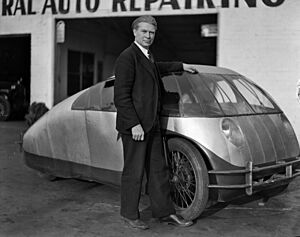Calvin Bridges facts for kids
Quick facts for kids
Calvin Blackman Bridges
|
|
|---|---|

Bridges with an automobile of his design, 1936
|
|
| Born | January 11, 1889 |
| Died | December 27, 1938 (aged 49) Los Angeles, California, US
|
| Alma mater | Columbia University (B.S., Ph.D.) |
| Known for | Heredity, polytene chromosome |
| Scientific career | |
| Fields | Genetics |
Calvin Blackman Bridges was an American scientist. He lived from 1889 to 1938. He made important discoveries in the field of genetics. He worked with other famous scientists. These included Alfred Sturtevant and H.J. Muller. They were part of Thomas Hunt Morgan's special lab. This lab was known as the "Fly Room" at Columbia University.
Contents
Early Life and Education
Calvin Blackman Bridges was born in Schuyler Falls, New York. This was in 1889. Sadly, he became an orphan very young. His mother died when he was two. His father passed away a year later. His grandmother then raised him.
Calvin finished high school when he was 20. Even with this challenge, he became a great student. He went to Columbia University in New York City. He studied there for both his first degree and his advanced degree.
While studying zoology at Columbia, Bridges met Thomas Hunt Morgan. This meeting was very important. It led to many big scientific discoveries. These discoveries were about genetics and evolution.
Work in the "Fly Room"
The "Fly Room" experiments started in 1910. They continued for 17 years. Thomas Hunt Morgan led these projects. Calvin Bridges worked closely with him. Other scientists like Alfred Sturtevant and Hermann Joseph Muller were also there.
Why Fruit Flies?
The "Fly Room" was the first to use common fruit flies. Their scientific name is Drosophila melanogaster. They used them for genetics research. Fruit flies were chosen for good reasons. They are cheap and easy to find. They also reproduce very quickly. This makes them perfect for studying how traits are passed down.
Key Discoveries
These experiments led to many early discoveries in genetics. They helped explain how genetic information is organized. This information is found inside chromosomes. They also showed how chromosomes are arranged. The team learned about linkage in sex chromosomes. Their work helped create modern ideas about genetics. It also shaped evolutionary biology. This was all before scientists knew about DNA. The group also learned how mutations affect evolution. Because of their success, D. melanogaster became a popular model organism. Scientists still use them for many types of biological research.
Improving Research Tools
Calvin Bridges made many improvements in the lab. He found better ways to do experiments. He also improved the equipment. For example, he suggested using binocular microscopes. Before, they used hand lenses. The new microscopes made data better. They also made work easier. Bridges also created better temperature controls. These new controls gave more useful and accurate results.
Important Publications
Bridges published many scientific papers. One famous paper was "Sex in Relation to Chromosomes and Genes." He also wrote for the Journal of Experimental Zoology and Science. His work with sex-linked traits suggested that chromosomes hold genes. Another scientist, Nettie Maria Stevens, later supported this idea. She studied fruit fly chromosomes. Bridges wrote papers proving this.
His PhD paper was about "Non-disjunction as proof of the chromosome theory of heredity." It was the first paper in the journal Genetics in 1916. In this paper, he also showed that the Y chromosome does not decide gender in Drosophila.
Bridges is well-known for observing polytene chromosomes. These are found in the salivary gland cells of fruit fly larvae. The patterns on these chromosomes are still used today. They help researchers find specific genes. Bridges was chosen for the National Academy of Sciences in 1936. This was for his important work with Drosophila.
After his death, his student Katherine Brehme Warren finished his work. She completed The Mutants of Drosophila melanogaster (1944). This book was a key resource for geneticists for 20 years. Its information was later moved to the FlyBase database.
Personal Life
Calvin Bridges married Gertrude Ives. They had four children together. He was known for being very smart and kind. He was also an atheist.

